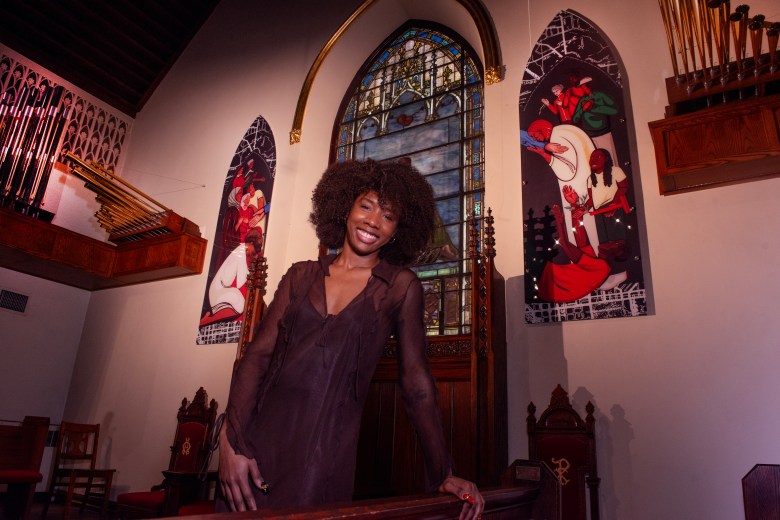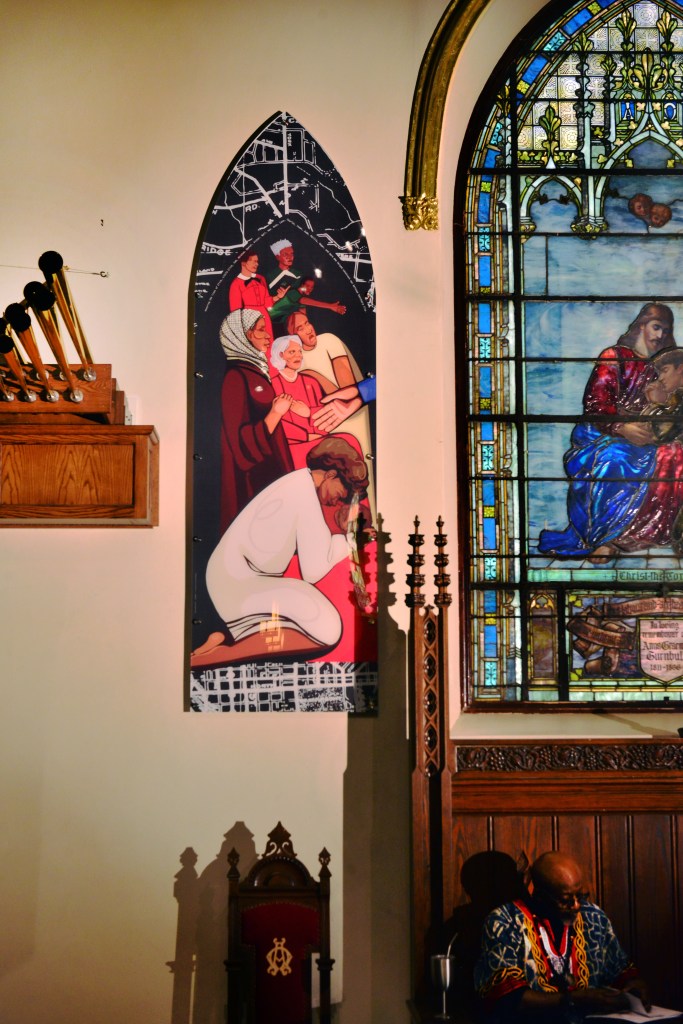Dear friends, let us love one another, for love comes from God. Everyone who loves has been born of God and knows God. – 1 John 4:7
“I don’t know if white Christians hate Negroes or not, but I know we have a Christian Church which is white and a Christian Church which is Black. I know, as Malcolm X once put it, the most segregated hour in American life is high noon on Sunday. That says a great deal for me about a Christian nation.” – James Baldwin on The Dick Cavett Show, 5/16/1969
On Sunday, February 9, 2025, Govans Presbyterian Church unveiled a historic and powerful permanent installation by mixed media artist Ky Vassor entitled Sanctuary City Parts I and II. Many Black, Latino, and Asian people — communities long deterred from membership — opted to attend the service not only to honor Vassor’s accomplishment but also to hear what the institution might have to say about its role in abolishing systemic oppression and racialized violence.
We are living in a redundant era, where mention of diversity feeds a woefully ignorant groupthink-borg-hive-mind with propaganda that some invisible encroaching enemy will take away their privileges. This false narrative corrupts democracy’s capacity, distracts the world from advancement, and prohibits those most in need from having what they and their families need to be well. Recently, that rhetoric tells us that the enemy is immigrants seeking sanctuary. On other days, that rhetoric proclaims it is the climate activists; protestors against genocide in Palestine, Congo, and Sudan; and women fighting for bodily autonomy. In other rants, the enemy is queer and trans lives fighting for their humanity to be acknowledged. The nation has a long history of demonizing Indigenous and Black lives, and that rhetoric is as old as the founding of the country.
The nation has a long history of demonizing Indigenous and Black lives, and that rhetoric is as old as the founding of the country.
Despite this morally deficient messaging that hopes our fear supersedes our logic and the power of our collective action, Govans, as an institution, has taken a brave stance to use its platform to stand up against injustice. They are still determining what this means and how this affects not only their congregation but also the community of North Baltimore, where their church resides. Govans has indicated that Vassor’s art commission will be the first of many substantial, rather than just symbolic, actions. Art cannot end centuries of oppression but can support robust discourse and motivate a community to grapple with complex realities to realize equitable solutions. This has always been the power of art.
Govans has indicated that Ky Vassor’s art commission will be the first of many substantial, rather than just symbolic, actions. Art cannot end centuries of oppression but can support robust discourse and motivate a community to grapple with complex realities to realize equitable solutions. This has always been the power of art.
The institution’s work to address oppression began in 2021 with an internal review of their diversity, including the figurative representations presented in the art they display, the racial makeup of their ministers, and the focus of their ministry. Designed in 1844 with the addition of a bell tower and chancel with a steeple added in 1905, the church celebrates many of the attributes of a Gothic Revival church. The most prominent feature, ecclesiastical stained glass windows, were installed from 1905 to 1910. Each window depicts scenes of Jesus and his disciples rendered in a style that rejects biblical descriptions of bronze skin and woolen hair in favor of likenesses popularized by European colonial expansion and missionary work around the world. In a brief segment during the service, the church acknowledged that these images, which overtly lack diversity, are unlikely to make non-white people feel welcome in the congregation. To try and counter this disparity, in 2024, Govans installed Minister Lea Gilmore as the Minister for Racial Justice & Multicultural Engagement and Reverend Dr. Ron Hankins as Govans Interim Pastor and established a Racial Justice Ministry Committee.
In that time, historian and longtime member of the congregation, Myra Brosius, in collaboration with the church’s Racial Justice Committee, has also been conducting extensive research about the history of the church and the grounds on which it was erected. What she found clarified that Govans, founded in 1844, nineteen years before the Emancipation Proclamation declared slavery unconstitutional, was a plantation that enslaved 30 men, women, and children of African descent. Moreover, well into the Jim Crow era, when the church had the opportunity to either integrate or erect a second church for Black, Latino, Indigenous, and Asian members, they refused to, which resulted in the church continuing to refuse the membership of non-white people well into the 20th century. As a result, the church remains overwhelmingly white but hopes its efforts will change not only the racial diversity of its constituency but also the consciousness of its congregation.
In early 2024, Govans began accepting proposals from community artists to design an artwork for their church that reflected their commitment to diversity. Vassor applied and received word a short time later that her design, Sanctuary City Parts I and II, two eight-foot-tall acrylic panels shaped like gothic stained glass windows, had won the commission. Vassor’s two panels flank a rendition of The Consoling Christ (1888), a recognizable painting created by German artist Bernhard Plockhorst, installed on the wall behind the pulpit, which overlooks the sanctuary. The copy featured in Govans’s stained glass window is known as Christ the Consoler and is distinguished by the inscription,

Photo Credit: I.H. Webster III.
“Come unto me, all ye that labour and are heavy laden, and I will give you rest,” as well as a dedication in remembrance of a major contributor to the church’s early renovations, Anna Graeme Turnbull. Coupled with Plockhorst’s work, Vassor’s panels create a dynamic triptych that references gothic and contemporary architectural motifs. With this commission, Sanctuary City Parts I and II represent the only artwork in the sanctuary that depicts non-white people.
During the opening ceremony, Vassor shared a moving speech that clarified who the work depicts, including Baltimore activists Lillian Kim, Lucille Gorham, and Pauli Murray, as well as those lost to police brutality, including Korryn Gaines and Freddie Gray. Vassor also acknowledged the names of the enslaved families who, up to that point, had not been publicly acknowledged by the church.
During the opening ceremony, Vassor shared a moving speech that clarified who the work depicts, including Baltimore activists Lillian Kim, Lucille Gorham, and Pauli Murray, as well as those lost to police brutality, including Korryn Gaines and Freddie Gray. Vassor also acknowledged the names of the enslaved families who, up to that point, had not been publicly acknowledged by the church.
“The mural’s panels acknowledge that Govans is situated on lands that were formerly part of a plantation, as illustrated by the map integrated into the gothic arches. This map delineates the perimeter of the land granted to William Govane by John Hopkins. At the top of each arch, the names of thirty enslaved individuals are prominently displayed: Dick, Mirigo, Davy, Tom, Solomon, Sue, Sal, Abigail, Jenny, Rachel, Cassie, Joshua, George, Juno, Peter, Elick, Little Elick, Sam, Abraham, Daniel, Victor, Nell, Nan, Kate, Cato, Charles, Isaac, Juda, Phillis, and Hagar…I am truly grateful for this opportunity. Each of these panels encapsulates Baltimore as a sanctuary city, embodying the unity and collective protection shared among its residents,” Vassor stated.
Govans Presbyterian Church is a rare example of an institution that boldly stands up against oppression, injustice, and the proliferation of historical violence against Black, Latino, Asian, Indigenous, and LGBTQ-identifying communities. By celebrating models of radical love instead of divisiveness, the church can promote how art as activism can enact systemic, policy, and legislative change in and beyond Baltimore City.

Photo credit: I.H. Webster III.
